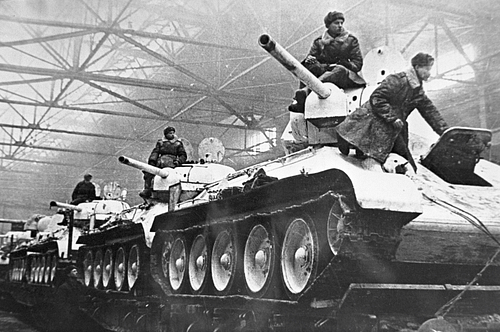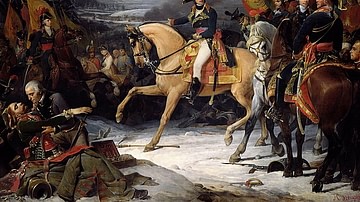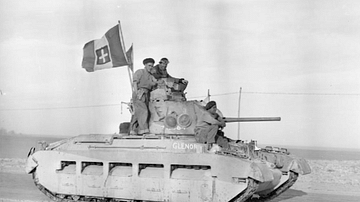The Battle of Smolensk in August to September 1943 was the second time the Soviet Union and the Third Reich fought over the city on the Dnieper during the Second World War (1939-45). By the summer of 1943, the plan by Adolf Hitler (1889-1945) to permanently occupy the USSR was in tatters. The Soviet Red Army was relentlessly pushing back and recapturing lost cities. Smolensk was to be next in a prolonged three-phase battle that ended any hopes Hitler might have had of winning the German-Soviet War.
The German-Soviet War
Hitler's decision to invade the USSR in the summer of 1941 with Operation Barbarossa had got off to a good start with massive territorial gains thanks to victories like the Battle of Białystok-Minsk and the Battle of Kiev in 1941. The following year, though, the Soviet Red Army began to fight back, winning the Battle of Moscow in 1941-2, holding out in the siege of Leningrad (Saint Petersburg), and resisting Hitler's Sixth Army at the Battle of Stalingrad, eventually winning that particular encounter in February 1943. Another large Soviet victory came at the Battle of Kursk in July and August 1943. The Axis armies simply had neither the men nor the material to face an enemy that was growing ever more powerful in size and ever more confident in ultimate victory in the German-Soviet War.
The Axis armies were now fighting a retreat, steadily losing the gains they had made earlier in the war. Smolensk was a case in point. The city, located on the Dnieper (Dnepr/Dnipro) river and the traditional gateway to Moscow, had been captured by Axis forces following the Battle of Smolensk in 1941. Now it was time to get the city back. Joseph Stalin (1878-1953), who had always had the final say on how the war was conducted, began to take an even more direct role. Stalin now prohibited encircling manoeuvres and told his commanders to instead focus on a wide front, utilising multiple direct attacks and employing a massive numerical superiority over the enemy. Stalin's new policy resulted in eight Soviet fronts with 19 parallel thrusts along a frontline over 1,000 km (660 mi) long. One of these thrusts involved the task of liberating Smolensk. This latter offensive was code-named Operation Suvorov, after the great Russian field marshal Alexander Suvorov (1729-1800). The problem for the Soviets was that they greatly underestimated how well dug-in the invaders were at this crucial crossing of the Dnieper.
Opposing Armies
The commander of the Soviets' Western Front was General Vasily Sokolovsky (1897-1968), who enjoyed the backing of Stalin. Sokolovsky was a good planner, but he had a reputation with his peers of being rather too cautious. Perhaps typically, Sokolovsky now split his offensive into two phases; the first would employ 16 divisions, and then a second wave of 22 divisions would be brought in. At this stage in the war, a standard Red Army rifle division had 6,500 to 7,000 soldiers. The elite 'Guards' divisions had around 8,000 soldiers. 'Rifle' division is a partial misnomer since a large number of Soviet infantry had a PPSh-41 submachine gun (or equivalent), not a rifle, which was more accurate. Most armour divisions were needed elsewhere, so only a minority of the Soviet tanks participating in Suvorov were the better T34 variety. Sokolovsky depended on his artillery units to compensate for the relative lack of tanks in the coming battle, and these included long-range 152-mm howitzers and multiple rocket launchers. The Red Army in WWII had still not perfected the necessary skills in logistics for large offensives, and many units would suffer from insufficient ammunition and a complete lack of rations in the coming offensive.
The commander of the Axis Army Group Centre was Field Marshal Günther von Kluge (1882-1944), who, like Sokolovsky, was a cautious leader. Kluge gave considerable autonomy to those below him, notably General Gotthard Heinrici (1886-1971). Heinrici's great forte was conducting defensive actions, and at Smolensk, he craftily thinned out his lines when the Soviet artillery was at its worst, but then managed to reinforce them ready for the infantry and armour attack. Kluge's tank units, like those of his Soviet counterpart, were not the best the Axis army could field, being mostly Panzer III and IV tanks, inferior to the Soviet T34 but better than the others the enemy fielded. In total, the Smolensk defence involved around 250,000 Axis troops, a large number, but including a significant proportion that was inadequately trained and without proper reserves. Like the Soviets, the Axis artillery crews did not have the required ammunition for a prolonged battle.
The Soviets had a distinct advantage in aircraft numbers at Smolensk, perhaps 3:1, but this was negated by the Axis aircraft having more fuel and so being able to fly more sorties per day. Axis pilots, particularly the best German and Spanish squadrons, were also far more experienced and deadly than their Soviet counterparts.
Battle: The First Phase
The battle lines formed around 20 km (12.5 mi) east of Smolensk. The Axis troops here had not wasted their two years in possession of the field and had built an extensive series of defences. However, Soviet partisans, up to 21,000 of them, operated behind the frontlines, causing havoc with the Axis supplies coming to Smolensk by train and road from early August. This deliberate sabotage strategy, sanctioned by the Red Army, was called Operation Rail War.
Operation Suvorov began on 7 August with the customary artillery barrage, first pounding the very front lines and then steadily moving to the secondary defences. When the armour and infantry divisions mobilised, they made little progress against the enemy's defences, which had been greatly underestimated. Indeed, the attack was suspended on 21 August in order to resupply and bulk up the Soviet forces, sufficient ammunition for the formidable array of artillery units being a particular problem. Even some rifle divisions had completely run out of bullets.
The problem for the Red Army's artillery personnel was that, because of the enemy moving their pieces around, "they did not know where more than half the German artillery batteries were located" (Forczyk, 22). The problem for the tanks and infantry was the number of water obstacles in this area and the patches of forest, both of which impeded troop movements and aided well-concealed defenders more than attackers. The sheer depth of the Axis defences along the front, which consisted of mines, anti-tank ditches, trenches, wire obstacles, camouflaged bunkers, and fortified villages either seriously slowed the advance or made no advance possible at all. The city of Smolensk was also ringed with similar concentric sections of defences. Breaking through these Axis defences was going to require another huge push.
At least the Red Army had seriously worn down the enemy's capabilities of prolonged defence (some Axis divisions were now down to a mere 30% of full strength). The enemy had also been forced to already engage its limited reserves. The Axis defenders had suffered around 28,000 casualties in this first phase of Suvorov. The Red Army had suffered around 75,000 casualties, but it still greatly outnumbered the enemy. If the Soviets could regroup and get their logistics together, the battle could certainly be won.
Realising the precariousness of his entire front in this area, on 12 August, Hitler authorised the construction of a series of defences to the west (near Vitebsk) as a place of retreat. This new line was called the Panther-Stellung and would not be completed until the end of September at the earliest (if ever). Army Group Centre had no choice for the time being but to try and hold on around Smolensk.

The Second Phase
The Red Army received an influx of new armour, including around 280 new tanks, and several new artillery battalions for the next push to Smolensk. However, the number of artillery shells available remained a problem, or, as one Soviet commander put it, "In terms of ammunition, we were kept on a starvation ration" (Forczyk, 59).
Operation Suvorov restarted on 28 August with a 90-minute artillery barrage. Gradually, the Red Army was forcing the enemy to retreat from its best defences to weaker ones, closer to Smolensk. The Axis forces were also being steadily worn down since there was no possibility of replacing losses. The towns of Yelnya and Dorogobuzh were liberated on 30 August and 1 September, respectively. If anything, the Soviet advance was progressing too quickly, as now the very front units began to run dangerously short of both fuel and ammunition. The retreating Axis forces were careful not to leave behind anything useful, and even when storage dumps had to be abandoned too quickly to be destroyed, as was the case at Yelnya, the Axis air force was used to destroy the supplies from the air. By 7 September, the Dnieper was reached, and the offensive was then paused for a second time for vital resupply.
The Third Phase
The Axis forces regrouped and were actually in a better position in terms of logistics now that the frontline had moved closer to Smolensk. On the other hand, the Axis airfields in the city were now directly under attack, and so Axis air support was greatly reduced in the coming third phase of the battle. The Red Army offensive resumed on 13 September. The next day, a breach was achieved in the Axis front. Two days later, a second breach was made. When the towns of Dukhovshchina and Yartsevo were liberated on 17 September, and the whole Axis front was in retreat, the way to Smolensk lay open. Some Red Army units still came under heavy fire; on 18 September, for example, a newly arrived unit of German Tiger tanks wiped out 26 Soviet tanks (for the loss of only one Tiger). The end of the battle was near, though, and Axis troops were ordered to prepare charges to demolish key infrastructures in Smolensk like the train station, water works, and electricity plant. In all, around 85% of Smolensk's buildings would be damaged or destroyed. By the time darkness fell on 24 September, most Axis troops had left the city, and behind them, they blew up three key bridges across the Dnieper. The remaining Axis units conducted a fighting retreat to the Panther-Stellung. Smolensk was liberated in the early hours of 25 September, and once more the Soviet flag flew over the city.
Operation Suvorov ended by 30 September as both sides regrouped. The Red Army had suffered around 450,000 casualties, which included 107,000 dead or missing. The Axis armies suffered around 54,000 casualties, which included over 14,000 dead or missing. The losses were smaller on the Axis side, but it could not bear them as the much larger Soviet military machine could.
Aftermath
The Nazi regime in Smolensk had been responsible for thousands of executions of civilians suspected of being partisans or collaborators, particularly in the last weeks of the battle. Jewish people had been another particular target. Einsatzgruppen, mobile Nazi killing squads, had committed atrocities everywhere involving men, women, and children almost as soon as the city had been taken over by Axis forces back in 1941. Revenge was now taken on certain captives and any civilians suspected of collaboration. A series of public hangings was carried out as a warning to the population.
In 1944, Hitler had not only to contend with a rampant Red Army in the East but the imminent prospect of an Allied invasion of Europe in the West. Following the D-Day operation of June 1944, Germany was obliged to fight on two fronts and lost both. Army Group Centre was destroyed in Operation Bagration in the summer of 1944. Berlin was overrun in May 1945 and Germany surrendered. The war in Europe was finally over.









